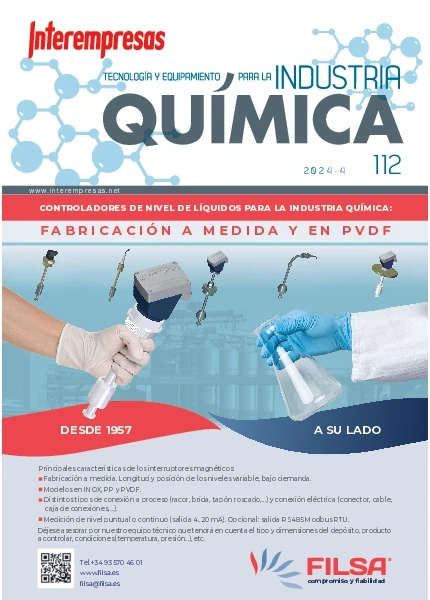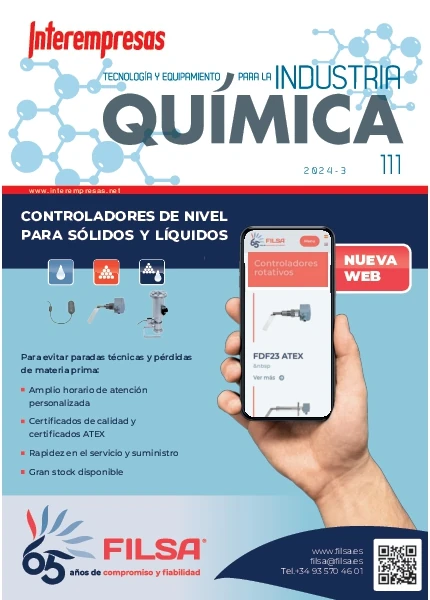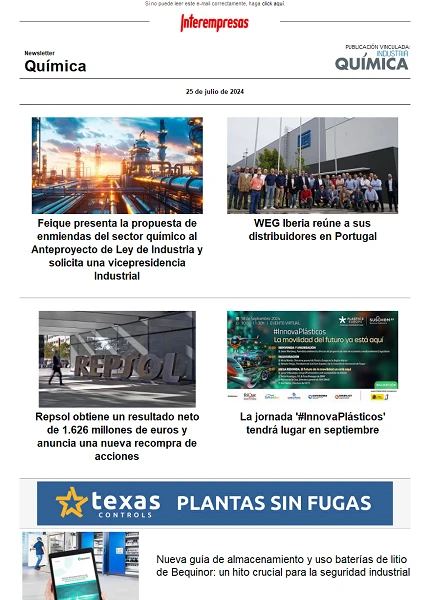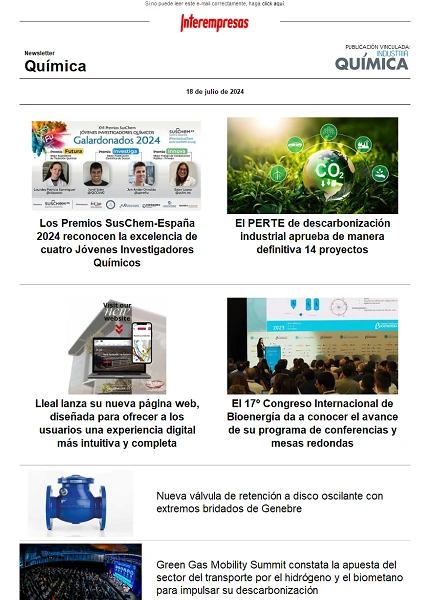Chemical sector, the key to sustainability
November 15, 2008
We mean when we speak of pollutants
Air pollution is any alteration of its natural composition, by the presence in the atmosphere of compounds that have adverse effects on human beings and their property, as well as animals and plants.
The air is contaminated when introducing substances other than its natural composition, either, when amending the quantities of natural ingredients. Air pollution can be caused by natural factors such as emissions of gases and volcanic ash, not arson smoke, dust and pollen and spores of plants, fungi and bacteria. However, the activities of humans, so-called anthropogenic pollution, pollution is which represents the most serious risk for the stability of the biosphere in general.
With regard to greenhouse gases, the most common are carbon dioxide, carbon monoxide, nitrogen oxides, hydrocarbons, oxides of sulphur, ozone and aerosol or particulate matter. These gases are generated in different processes, but the main emission source is combustion. There are other pollutants, whose harmful effect is much larger, such as halogen, volatile organic compounds and their derivatives (CFCS, HFCS), sulfur compounds and metal particles, among others in lower concentrations in the atmosphere.
Each of these pollutants have different effects in the atmosphere. Carbon dioxide is thus responsible for 64 percent of the greenhouse effect that is causing global warming of the planet; CFCs, which cause the increase of the hole in the ozone layer and also contribute to climate change, while oxides of sulphur and nitrogen when combined with atmospheric water vapor caused acid rain.
While the variety of processes taking place in the chemical sector is that this will contribute to increasing the concentration of air pollutants, "air pollution - says Cecilia Foronda, responsible for CeroCO2, of the Foundation ecology and development - is a wider problem"which involves more phenomena; "the indisputable fact, as the last report of the IPCC, that climate change is already occurring and that its impact could be much higher if action is not taken immediately, has motivated to reduce the concentration of GHG in the atmosphere has become a priority for the international community."
So they have it
But, what currently is the level of atmospheric emissions of Spanish and what industry the maximum set by the existing legislation? If we focus on greenhouse gas emissions, the European Union, within the framework of the Kyoto Protocol, assumed the obligation to reach a reduction of 8 per cent of the emissions of greenhouse gases in the year 2012, and in the case of Spain, the commitment is not exceed by more than 15 per cent of 1990 emissions. Far from this objective, and already immersed in the first year of implementation of the Protocol, emissions have increased more than 50 per cent in our country.
The last Spanish inventory of GHG released in 2007 indicated that the contribution of industrial processes emissions of greenhouse gases in the Spanish State was from 7.7% in 2005 reaching almost 34,000 equivalent tonnes of CO2.
These figures show that it is necessary that all sectors, not only the industrial, assume its share of responsibility in the climate change and take action to redirect the tendency of increase of greenhouse gas emissions and achieving closer to the target set for 2012.

… And here's the chemistry
With regard to emissions from the use of heating or cooling in buildings, the chemical industry develops thermal insulation to reduce up to 80 percent of energy consumption.
Another milestone in reducing emissions attributable to the chemical industry is the development of substitutes for CFCs, main cause of the disappearance of the ozone layer. In this regard, United Nations has estimated that without the substitutes for the CFCs 50 per cent of the ozone layer would have gone to the year 2035.
Chemistry has also given response to the need for reduction of emissions of volatile, destroying organic compounds of the ozone layer, imposed by European legislation, looking for alternatives to solvents: water, pigments resistant to corrosion or binders and resins compatible with water.
It's finding "chemical solutions to climate change", as reads the slogan of the exhibition held in the framework of the international exhibition of chemical in its 2008 Edition, which took place in Barcelona between the past days 20 to 24 October. Not in vain, the European chemical industry is characterized by its constant capacity for research and innovation, which gives rise to new materials and manufacturing processes, fundamental in the fight against the effects of climate change.

Expenditure of enterprises in environmental protection. Air emissions
Year 2006. Units: EUR
Extractive industries 2.857.600
Manufacturing 164.354.195
Industry of food, beverages and tobacco 8.155.789
Textile and clothing 371.967
155.989 Footwear and leather industry
Industry of wood and Cork 3.780.284
Industry role, editing, graphic arts, etc. 4.838.630
Refining of oil and processing of nuclear fuel 8.769.201
Chemical industry 22.328.030
The processing of 4.112.804 plastics and rubber industry
34.741.407 Non-metallic mineral products industries
Metallurgy and manufacture of metal products 62.564.730
The construction of machinery and mechanical equipment 2.375.354 industry
Industry of electrical, electronic and optical equipment 1.578.625
8.847.712 Transport equipment manufacture
Manufacturing various 1.733.673
Production and distribution of electric power, etc. 74.483.416
Dumps in the investment
By communities, Catalonia was that more investment allocated for this purpose during 2006: 228 million euros, a fifth of the national computation. Followed by Galicia, with 131 million invested, and Asturias, with EUR 120 million.
In the balance of current accounts, industries afincadas in Catalonia spent on environmental protection of EUR 400 million, 28 per cent of the total of the State. Andalusia and Valencian succeeded him in this ranking.
The latest available data show that the companies in the chemical sector aimed at the protection of the environment the 20 per cent of the total investments of Spanish companies. On the other hand, sector allocates 20 percent of their investments to safety in industries; Prevention and protection are among the main concerns of the sector.
Through the innovation of everyday products, the chemical industry can contribute to achieving a sustainable society with simple and cheap to take measures. According to Feique, chemical innovation can reduce by 50 per cent the energy consumption of housing. The same sources indicate that the chemical industry brings together the 25 per cent of all investments dedicated to r & d in the private sector, and that one of every five researchers belong to the private chemical industry.
In a nutshell
The data
According to the European Association of insulation manufacturers, each tonne of CO2 generated in the production of insulation, a development of the chemical industry, saves 200 tons of emissions in the housing. The widespread use of standard isolates in Europe would make it possible to avoid the issuance of 370 million tonnes of CO2, almost 40 percent of the objectives of reduction of the EU.
Geography and urban planning
There are various conditions that facilitate air pollution. There are geographical, landforms and altitude conditions.
But there are also conditions urban development, distribution and number of industries, gardens, streets and parks. In cities where growth has not been planned, the industrial zones surround increasingly residential and housing sets; This causes a direct contamination effect to persons residing in these locations.
Chemical solutions
Different techniques and chemical treatments are used for the regeneration of contaminated soil or for the treatment of wastewater. For the protection of biological diversity, which has been affected by agriculture not planned, the chemical industry developed in his day, plastic for greenhouse, which allows to meet the growing demand for food without having to invade new natural spaces.
Consequences of air pollution
In people, to pulmonary level can cause asthma, emphysema, lung cancer and bronchitis; in the skin, spots, cancer, conditions in the mucous membranes of the nose, skin irritation in the eyes and conjunctivitis, also aggravates cardiovascular disorders, among other diseases.
In materials, it can cause deterioration in those that are used in buildings and other surfaces. This is one of the fields on which the chemistry is delivering successful solutions.
In plants, it disrupts the process of photosynthesis.
Among the environmental problems caused by pollution of the air: smog (*) of large cities, changes of climate at global and regional levels, the greenhouse effect, acid rain and the decrease in the ozone layer.
Green aircraft
The research team of Boeing in Madrid did fly some months ago a device's small size, with a set of stacks of hydrogen as an energy source. And it is that large enterprises of the aeronautical sector, in collaboration with companies in engineering, chemistry, and a number of universities, work in the study of alternative fuels and improvement of designs that aligeren the components of the airframe. In the development of the "green group" must meet the following requirements: less energy consumption, reduction of emissions of CO2 and decrease of the noise
(*) The term 'smog', a result anglicism of the words smoke (smoke) and fog (fog), began to be used at the beginning of the 20th century in England to describe a thick fog laden with toxic substances such as soot and sulphur, as a result of the atmospheric pollution caused by the combustion of coal.
This is the Plan…
The decision to deliver emission rights to generators for free during the 2005, 2007, 2008 and 2012 was a political decision on how to distribute the income generated by the initial allocation of emission rights between producers and consumers. From the year 2013, emissions may assign other methods, as auctions (in fact the proposal for a new directive sets the auction as a unique tool for the electricity sector).
Permission to issue
Here is a summary of the bases that characterize the National Plan of allocation of emissions for the period 2008-2012:
- The sectors affected by the directive accounted for 40% of total emissions in NIP I and reach 45% of total emissions in Napa II.
- NIP II is reduced the total allocation of rights by 16.4 per cent from the first NIP.
- Expands the reserve for new entrants, from 1.84% NIP I, to 4.3% in the NIP II (percentage of reservation on assignment).
- New entrants will be those who so request and are in line with nominal capacity of existing facilities and new facilities.
- He is the criterion of greater demand for the electricity sector because this which can evolve more easily and at lower cost to production with clean technologies. Also, it is the less exposed to international trade and, therefore, it has greater ability to internalize the cost of reducing CO2 in the final price.
- The possibility of complying with the emission reduction obligations through certified reductions in emissions (CERs) and of emission reduction units (ERUS) is reduced, in the electricity sector, from 70% to 42%, and in the rest of the industry, 20 per cent to 7.9 per cent of the total emissions.
- The amount of CERs and ERUS obtained should be used each year and not at any time during the period 2008-2012, although the unused fraction can accumulate to later periods.
Rights of emission and competitiveness
Industry sources warn that the new rules can degenerate into relocation of chemical firms in Europe to other countries where such regulations would not apply, "lost - they put - a sector that generates much of European wealth and large number of stable jobs". Other end on the alert refers to environmental standards, which are better and more demanding in Europe. This is compounded by the fact that, in case of moving companies to third countries, they should carry the products and return to Europe, with the consequent emission of gaseous pollutants as a result of the transport. In this regard, the sector is of the view that "impose such contributions encourages the relocation of businesses to other geographical areas, but no benefit to the environment environmental global". The manifestations of the chemical industry concludes that "the extent of the European Commission would be feasible and fair provided the majority of countries committing to implement similar measures, thereby the protection of the environment would be globally and the competitiveness of the companies would not be affected".
It is clear that the Government will have to consider that the economic impact of the directive is distributed in asymmetrical shape among the six sectors concerned. Sectors such as the cement and, to a lesser extent, the electric emit a relatively high amount of emissions per euro added value generated, while the intensity of emissions per euro of value added is low in sectors such as paper and glass and ceramics.
In any case, the plan of emissions must be particularly careful with the sectors with a high intensity of emissions - in that order, cement, electricity and refining - which are the ones most accuse the implementation underway emissions market.
Faced with the complicated situation, some weeks ago, the EU curbed the Kyoto II objectives; the French Presidency of the EU has proposed a list of sectors that more might be affected by the relocation of factories to places with a more permissive environmental legislation. The paper notes that "the sectors or sub-sectors at the highest risk must to have 100 percent of free emission rights", and it is the response to the demands of, among others, heavy, steel, petrochemical, cement industryChemistry and trash, which have been warning of the impact that European plans against climate change can have on the economic front and on employment.
From 2013 some industrial sectors should begin to pay fees for the emission of CO2, something which at present is granted free of charge.

Abracadabra…
The Spanish technological platform of the CO2, which brings together 70 public and private entities, since electricity such as Endesa and Union Fenosa to ministries, research centres and universities, through has launched 14 projects to promote new technologies to retain the CO2 in industrial chimneys. Stop expel air into the atmosphere and bury him under the ground is the shortcut you are looking for to reduce the emission of gases that warm the planet. To this end, the EU has developed a proposal for a directive to regulate the authorizations for the storage of CO2 in the ground in each country. And it is that although Europe expected to replace a third of the thermal coal in 10 years and replace them with other cleaner, coal consumption increases in countries such as China, India and other emerging regions. China has 25 percent of the world of coal reserves and the capture of CO2 is shaping up as almost indispensable solution. The Institute of geological and mining Spanish analyzes the most suitable geological formations for the underground storage of CO2.
The technologies of capture of CO2 are aimed, firstly, to the electric, but can also encourage all industries affected by trade in emissions, such as chemistry, the steel or the trash. In fact, the industries gas and oil company have experience in the methodology of assessment of the actual feasibility of geological deposits. The proposal for a directive on storage of CO2 requires that the new combustion plants aside space for teams of capture and compression of the CO2, and to evaluate if they have warehouses of CO2 and transport networks - pipes, ship, camión…. The Spanish platform for the CO2 provides that our country has the first centers of capture and storage demonstration scale by 2015 and that capture technologies to expand from 2020.
Energy alternatives
The crisis in the oil market forces to take a new direction, to reinvent the history of the development of humanity. We are witnessing the revival of nuclear energy, whose waste not yet have achieved dealing with efficiency. Renewable energy, such as solar, wind power, the mereomotriz, geothermal or biomass, are difficult to transport and store, and its amount varies according to external agents. Nuclear fusion is one of the big bets at the theoretical level, but technical difficulties which includes implementation, her do, for now, unworkable, since temperatures higher than 100 million degrees is needed so that there is fusion reaction; as well as materials to resist high temperatures and radiation; ensure that the energy released is greater than is necessary to heat and maintain the fuel isolated, and ultimately develop devices that capture the energy generated and render in electricity, in such a way that the entire process is obtained a sufficiently positive energy balance. Biofuels have the drawback of that to increase its production significantly, should devote a lot of fertile land to its cultivation, which is incompatible with the famine and desertification plaguing our planet. Experiments with bioenegía, obtained by genetic mutations, so clean, they occur in all parts of the world, but we are still very far from a massive introduction. Research on the matter are some curious headlines: find a bacteria that eat pollution and generates electricity; They produce hydrogen from sunflower; Scientists see jojoba as an alternative to the diesel oil; NASA tries to create a bacteria present in human excrement fuel; As in Mad Max, pig feces are used to generate energy; Spanish researchers turn straw into fuel; and we could continue...
Hydrogen is also emerging as an alternative, at least on paper. This is extracted from the water, abundant on the planet resource, fuel and combustion air is clean. Disadvantages: as it is not a primary fuel are incurred a cost to obtain, in addition, occurring from other fossil fuels (according to a report by the World Watch Institute, now 99 percent of the hydrogen produced in the world is obtained through the consumption of oil or natural gas); It requires expensive and still little developed storage systems; the high cost of energy in its liquefaction, and the high price of pure hydrogen.
However, already exist in the market some mobile phones with hydrogen battery and there are also buses in Madrid and Barcelona, operating on this system.
But the energy model that governs us today has another peculiarity: gives the control of the global energy to a small number of companies (which as a general rule, in turn, have interests in other economic areas) and, moreover, are in the permanent process of mergers; so that the welfare of much of humanity depends on them. There is no doubt that the energy model is not only crucial environmental, but also in security and international policy and, in addition, in the social field.
Jeremy Rifkin, author of 14 books on the impact of science and technology in the economy, society and the environment) claims thereon an interesting theory according to which the adoption of hydrogen as an energy alternative would lead to the construction of a more just society. Hydrogen is practically inexhaustible and is equally distributed on the planet which would guarantee a democratic governance; an economy based on hydrogen recompondría the world Organization allowing more equitable power redistribution, while its production could take place from domestic resources, economic and environmentally acceptable way. Rifkin describes a network of energy distribution in which every citizen could become producer in addition to consumer of its own energy; a network made in the image of the World Wide Web, in which millions of end users connecting its fuel cells to hydrogen energy networks local, regional and national, to share energy.
C.K. Parlad, consultant in development of the United Nations has manifested itself recently with a similar theory, but on the source of democratizing energy from the Sun.
What happens with the South?
In view of the commitment that India and China took some time for the development of a large industry of wind and solar energy, as well as others since 2004 been been producing, and bearing in mind that China is already the second country in the world with higher emissions of carbon dioxide, it is possible that both countries lead the shift towards a new economic system and social world, if they plan their growth on the basis of energy production and agriculture sustainable. Perhaps, and hopefully, these countries give us a lesson in wisdom and bet by undertake their development through sustainability, which would lead to a qualitative leap which would place them ahead of the current industrial powers.
More examples. A few weeks ago closed the Fourth World Congress of nature - held in Barcelona, who tried to lay the groundwork for a capitalism based on natural resources and which revealed the need to quantify the economic value it provides nature and its ecosystem services. Day Ecuador supported renounce the exploitation of new oil fields in an area of the Ecuadorian jungle of great natural value in return for compensation. Costa Rica, for its part, there is the goal of achieving a zero emissions of greenhouse gases for the year 2021, through reforestation policies.










































